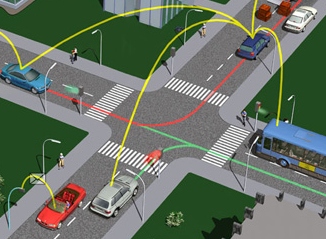Car-to-kerb comms gets developer boost
NEC releases development toolkit to underpin its car-2-car vehicle to roadside communications technology for relaying traffic, road safety and other telemetry data.

Electronics giant NEC has released a set of developer tools for car-2-car telemetry technology, with the aim of helping software developers create and integrate support for the short-range vehicle communications protocol into applications and critical systems.
Car-2-car communication involves using wireless data to allow cars to communicate with each other and sensors in the road. For safety purposes the technology would allow a car to detect whether it was approaching a hazard using wireless information from the cars ahead of it and road sensors embedded at the kerb or in the road surface. Safety features in the car such as speed limitation, emergency braking etc could then be engaged to avoid or safely pass the hazard.
It could also improve traffic flow, as shared telemetry data could alert drivers of congestion and slow moving vehicles. When integrated with satellite navigation applications using developer tools like the NEC Car2X SDK, the data would assist in re-routing and avoiding gridlocked areas. Car-2-car technology would also allow the car to potentially access a wireless internet connection while travelling along a road.
Telemetry data could even be used at a scene of an accident, where forensic teams could use telemetry data from the accident location to digitally reconstruct the events leading up to the incident.
"In-car applications are not our core business." Dr Heinrich Stttgen, vice president of NEC's European laboratories said. "So what we decided to do instead of waiting for a product to be ready was to allow those people who were building in-car communications applications to experiment with the technology. I think other people in the industry are doing it and it's a way of attracting future users."
Yesterday NEC showcased its work in car-2-car and car-2-roadside sensor technology at its R&D centre in Heidelberg, Germany. IT PRO was shown a demonstration of the technology, which involved the integration of wireless sensor networks between cars and the road surface.
The scenario involved sensors being installed at several points on a dangerous bend. These sensors could sense information on the conditions of the road such as surface temperature, humidity and light to approaching cars equipped with a compatible receiver and transmitter. When it approached the bend, the car would receive the road condition data but also relay this information on to the car behind it and so on.
Get the ITPro daily newsletter
Sign up today and you will receive a free copy of our Future Focus 2025 report - the leading guidance on AI, cybersecurity and other IT challenges as per 700+ senior executives
Communication between cars and the kerb uses the 802.15.4 wireless RF standard, while geocasting (car-to-car data transfer) is done using 802.11p.
Car companies looking at the technology include Audi, BMW, Fiat, Honda, Renault and Volkswagen.
Stttgen said that European standardisation was necessary for the technology to become a reality. "The German market or the UK market by itself would be way too small to justify the investment. Furthermore for example, if you took your car from Germany into France you would still want the sensor technology to work."
"It is also a deployment issue. The question whether a sensor network would work well depends on how many cars are using the technology. For example, if just new cars had this technology, that's not a network. You would have to have at least at 10 per cent penetration rate before you would see a network developing and it would be useful to everybody. The manufacturer's devices need to work together and it needs more standardisation than only the communication devices and protocols itself."
The developer toolkit is available now from the NEC website.

